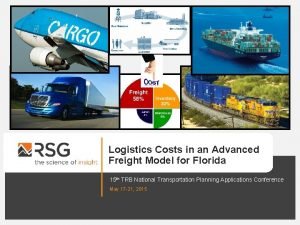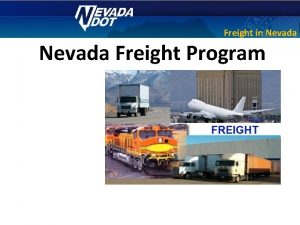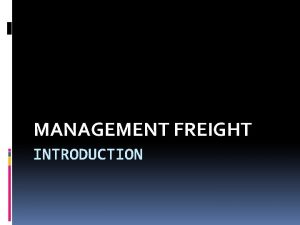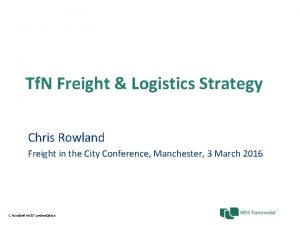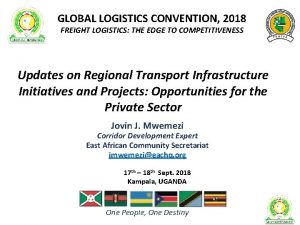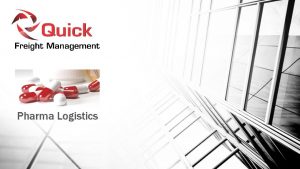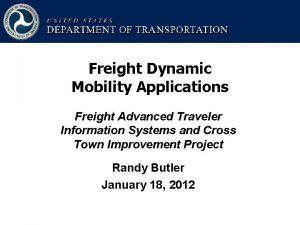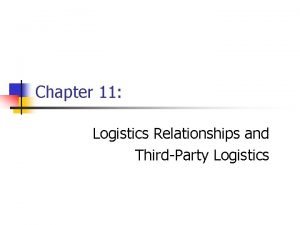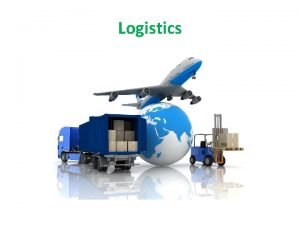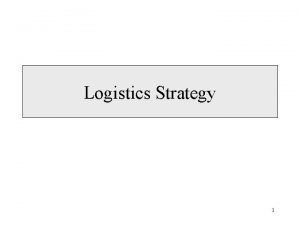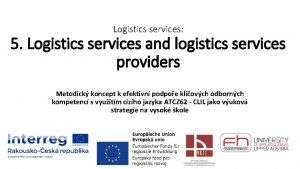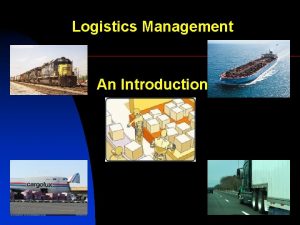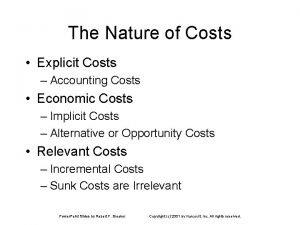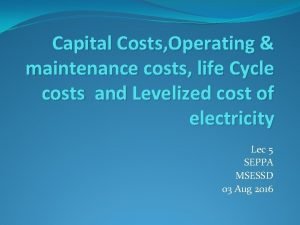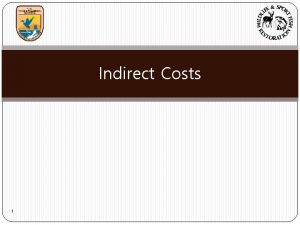Logistics Costs in an Advanced Freight Model for
















- Slides: 16

Logistics Costs in an Advanced Freight Model for Florida 15 th TRB National Transportation Planning Applications Conference May 17 -21, 2015

Introduction Tour-based and logistics supply-chain modeling framework (FHWA) Applied to Florida Logistics Decisions (mode choice ) Inventory Costs Variable Costs Commodity Characteristics 05. 2015 RSG 2

Florida Statewide Freight Model 05. 2015 RSG 3

Florida Model Integration 05. 2015 RSG 4

Florida Statewide Freight Model Firm Synthesis Supplier Selection Goods Demand Distribution Channel Shipment Size Mode and Transfers 05. 2015 RSG Synthesizes a list of businesses in Florida, the rest of the US, plus an international sample Connects suppliers to buyers based on the commodities produced by the supplier and consumed by the buyer Distributes commodity flows amongst the paired suppliers and buyers For each buyer/supplier pair, selects whether shipments are direct or involve intermediate handling (intermodal, distribution center) For each buyer/supplier pair, converts an annual commodity flow to shipments by size and frequency Identifies the mode for each leg of the trip from supplier to buyer and the transfer locations 5

Mode Choice Model Shipments are Assigned to the Following Modes: • Truck (Full truck load, less than truck load) • Rail (Carload, intermodal) • Water (international, non -international) • Air Paths for shipments with complex distribution channel (that are not direct from shipper to buyer) can be multimodal, e. g. • Truck – Rail – Truck • Truck – Air – Truck • Truck – Water 05. 2015 RSG 6

Mode Choice Model structure based on the Aggregate-Disaggregate-Aggregate (ADA) framework** Ø Disaggregation of commodity flows at their production and consumption ends to firm-to -firm flows, shipping and receiving firms paired then treated as a single behavioral unit Ø Modeling of logistics decisions that are made by the shipper-receiver pair based on evaluation of the total transport and logistics costs on available paths; and Ø Aggregation of individual shipments to origin and destination zones for network assignment purposes ** implemented in Norway and Sweden by de Jong and Ben-Akiva 05. 2015 RSG 7

Total Costs = Transport costs + Non-Transport costs Non-Transport Costs = ordering Order preparation, order transmission, production setup if appropriate + carrying Cost of money, obsolescence, insurance, property taxes, and storage costs + damage Order lost or damaged + Inventory in-Transit + Safety Inventory 05. 2015 RSG Inventory between shipment origin and delivery location Lost sales cost, backorder cost (Demand Lead-time uncertainty) Very important for high-tech commodities (electronics) 8

Total Cost Equation Transport and Ordering Cost Handling Cost Variable or Parameter Gmnql Q q b 0 ql b 1 T b 2 j v b 3 t b 4 b 5 a LT s. Q s. LT 05. 2015 RSG Damage Cost Inventory in-transit cost Carrying Cost Description or Interpretation (of Parameters) Logistics cost (shipper m and receiver n with shipment size q and logistics chain l) Annual flow in tons Shipment size in tons Alternative-specific constant Constant unit per order Transport and intermediate handling costs Discount rate Fraction of shipment that is lost or damaged Value of goods (per ton) Discount rate of goods in transit Average transport time (days) Storage costs per unit per year Discount rate of goods in storage Constant, set safety stock a fixed prob. of not running out of stock Expected lead time (time between ordering and replenishment) Standard deviation in annual flow (variability in demand) Standard deviation of lead time Safety Stock Cost Source Calculated in the model FAF Variable Parameter to be estimated network skims, survey data Parameter to be estimated Survey data or assumed value FAF data Parameter to be estimated Lookup table (or skims), survey data Parameter to be estimated Survey data or assumed value Lookup table (or skims) , survey data Survey data, assumed value Lookup table (or skims), survey data 9

Equation modification Transport and Ordering Cost Handling Cost Damage Cost Inventory in-transit cost Carrying Cost Safety Stock Cost ü Term “j” is redundant (the fraction of shipment that is lost or damaged) ü Unit = tons (safety inventory level), should be multiplied by the cost of holding safety inventory. ü Only “Transport”, “Inventory in-transit” and “Safety stock” costs are reliant on “cost” and “time” from skims (the model performs the shipment size choice before mode choice). Transport and Handling Cost Inventory in-transit cost 05. 2015 RSG Safety Stock Cost 10

Product and Supply Chain Types Safety Stock Cost o Depends on product type o Depends on supply chain type and service level o Depends on product demand patterns Innovative Products Mature product Low product variety Predictable demand minimize inventory Greater reliance on low cost modes Early life cycle stage High product variety Unpredictable demand Deploy significant buffer stocks Greater reliance on fast and reliable modes Different parameters 05. 2015 RSG Responsiv e Supply Chain Categorizing commodities Efficient Supply Chain Functional Products Functional Product Innovative Product MATCH MISMATCH 11

Model Run Comparisons Commodity Wood Products Origin FAF 129 (Florida, remainder) Segment Internal - Internal Destination FAF 123 (Florida, Orlando) Cost type ($) Formula Constant B 0 Q*C Transport Inventory in-transit B 3*(t/(24*60))*v*Q/365 B 5*v*a*((LT)*(Qsd)^2)+(Q^2+(LTsd)^2))^0. 5) Safety Stock B 1*(Q*2000/q) Ordering B 2*j*v*Q Damage (B 4+(B 5*v))*((q/2000)/2)) Carrying TOTAL COST ($) Shipment Characteristics 05. 2015 RSG c ($) t (min) Q (tons) GCD (mile) Value ($) v ($/ton) LT (days) Truck Rail Air Water 2, 788. 9 2, 739. 9 99, 999, 999 247. 7 266. 3 4, 406. 4 N/A 0. 4 0. 7 0. 5 N/A 1, 314. 5 1, 452. 7 1, 378. 4 N/A 50. 0 1. 2 15, 581. 6 19, 984 20, 092 N/A 39. 9 42. 9 709. 7 N/A 1, 602. 6 3, 284. 8 2, 380. 2 N/A 6. 2 89. 5 2, 365. 3 380. 9 11. 1 12. 3 11. 7 N/A 12

Model Run Comparisons Commodity Electronics Origin FAF 123 (Florida, Orlando) Segment Internal - External Destination FAF 379 (North Carolina, remainder) Cost type ($) Formula Constant B 0 Q*C Transport Inventory in-transit B 3*(t/(24*60))*v*Q/365 B 5*v*a*((LT)*(Qsd)^2)+(Q^2+(LTsd)^2))^0. 5) Safety Stock B 1*(Q*2000/q) Ordering B 2*j*v*Q Damage (B 4+(B 5*v))*((q/2000)/2)) Carrying TOTAL COST ($) Shipment Characteristics 05. 2015 RSG c ($) t (min) Q (tons) GCD (mile) Value ($) v ($/ton) LT (days) Truck Rail Air Water 2, 309. 6 5, 122. 6 846. 2 99, 999 17. 8 22. 2 777. 9 N/A 3. 3 26. 1 13. 6 N/A 31, 485. 8 39, 791. 6 35, 245. 5 N/A 776. 0 30. 3 160. 0 34, 783 45, 929 37, 850 N/A 45. 9 57. 2 2, 005. 0 N/A 578. 3 4530. 2 2, 367. 2 N/A 0. 39 518. 5 12, 105. 9 31, 201. 5 10. 4 13

Model Run Comparisons Commodity Pharmaceuticals Origin FAF 139 (Georgia, remainder) Segment External - Internal Destination FAF 129 (Florida, remainder) Cost type ($) Formula Constant B 0 Q*C Transport Inventory in-transit B 3*(t/(24*60))*v*Q/365 B 5*v*a*((LT)*(Qsd)^2)+(Q^2+(LTsd)^2))^0. 5) Safety Stock B 1*(Q*2000/q) Ordering B 2*j*v*Q Damage (B 4+(B 5*v))*((q/2000)/2)) Carrying TOTAL COST ($) Shipment Characteristics 05. 2015 RSG c ($) t (min) Q (tons) GCD (mile) Value ($) v ($/ton) LT (days) Truck Rail Air Water 2, 194. 2 903. 5 1, 268. 0 99, 999 1. 5 2. 2 74. 7 N/A 0. 3 3. 0 1. 7 N/A 3, 814. 5 4, 781. 8 4, 318. 8 N/A 50. 0 3. 7 287. 3 6, 352 6, 031 5, 877 N/A 36. 7 53. 2 1, 801. 9 N/A 470. 8 4, 242. 3 2, 285. 6 N/A 0. 04 342. 0 1, 477. 2 36, 061. 1 10. 3 11. 6 10. 3 14

Mode Choice Validation Results By Mode Tons (%) 80% Transearch Model 60% 40% 20% 0% Air Rail Truck Water By Mode Value (%) 100% Transearch Model 80% Calibration of the mode choice model resulted in a relatively good match to the mode choice shares observed in the Transearch data 60% 40% 20% 0% Air 05. 2015 RSG Rail Truck Water 15

Contacts www. rsginc. com Kaveh Shabani kaveh. shabani@rsginc. com Colin Smith colin. smith@rsginc. com Maren Outwater maren. outwater@rsginc. com
 Advanced freight logistics
Advanced freight logistics Agil freight logistics qatar
Agil freight logistics qatar Fspos
Fspos Typiska novell drag
Typiska novell drag Tack för att ni lyssnade bild
Tack för att ni lyssnade bild Vad står k.r.å.k.a.n för
Vad står k.r.å.k.a.n för Varför kallas perioden 1918-1939 för mellankrigstiden
Varför kallas perioden 1918-1939 för mellankrigstiden En lathund för arbete med kontinuitetshantering
En lathund för arbete med kontinuitetshantering Kassaregister ideell förening
Kassaregister ideell förening Tidbok för yrkesförare
Tidbok för yrkesförare Sura för anatom
Sura för anatom Densitet vatten
Densitet vatten Datorkunskap för nybörjare
Datorkunskap för nybörjare Boverket ka
Boverket ka Tes debattartikel
Tes debattartikel Delegerande ledarskap
Delegerande ledarskap Nyckelkompetenser för livslångt lärande
Nyckelkompetenser för livslångt lärande
